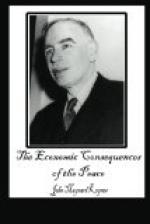II. Organization
The delicate organization by which these peoples lived depended partly on factors internal to the system.
The interference of frontiers and of tariffs was reduced to a minimum, and not far short of three hundred millions of people lived within the three Empires of Russia, Germany, and Austria-Hungary. The various currencies, which were all maintained on a stable basis in relation to gold and to one another, facilitated the easy flow of capital and of trade to an extent the full value of which we only realize now, when we are deprived of its advantages. Over this great area there was an almost absolute security of property and of person.
These factors of order, security, and uniformity, which Europe had never before enjoyed over so wide and populous a territory or for so long a period, prepared the way for the organization of that vast mechanism of transport, coal distribution, and foreign trade which made possible an industrial order of life in the dense urban centers of new population. This is too well known to require detailed substantiation with figures. But it may be illustrated by the figures for coal, which has been the key to the industrial growth of Central Europe hardly less than of England; the output of German coal grew from 30,000,000 tons in 1871 to 70,000,000 tons in 1890, 110,000,000 tons in 1900, and 190,000,000 tons in 1913.
Round Germany as a central support the rest of the European economic system grouped itself, and on the prosperity and enterprise of Germany the prosperity of the rest of the Continent mainly depended. The increasing pace of Germany gave her neighbors an outlet for their products, in exchange for which the enterprise of the German merchant supplied them with their chief requirements at a low price.
The statistics of the economic interdependence of Germany and her neighbors are overwhelming. Germany was the best customer of Russia, Norway, Holland, Belgium, Switzerland, Italy, and Austria-Hungary; she was the second best customer of Great Britain, Sweden, and Denmark; and the third best customer of France. She was the largest source of supply to Russia, Norway, Sweden, Denmark, Holland, Switzerland, Italy, Austria-Hungary, Roumania, and Bulgaria; and the second largest source of supply to Great Britain, Belgium, and France.
In our own case we sent more exports to Germany than to any other country in the world except India, and we bought more from her than from any other country in the world except the United States.
There was no European country except those west of Germany which did not do more than a quarter of their total trade with her; and in the case of Russia, Austria-Hungary, and Holland the proportion was far greater.




